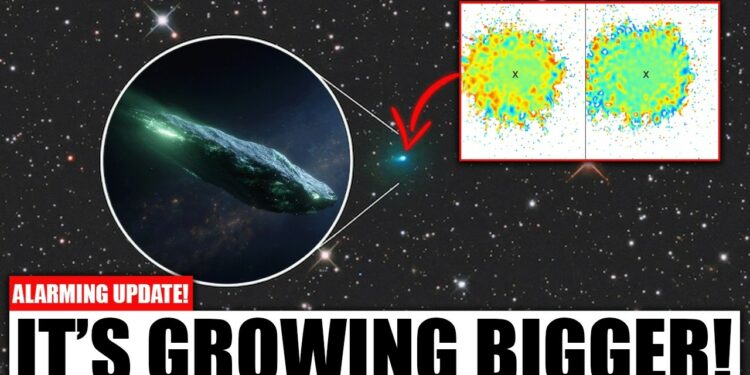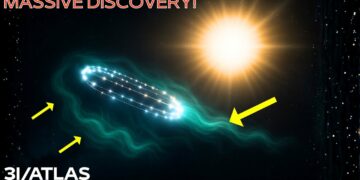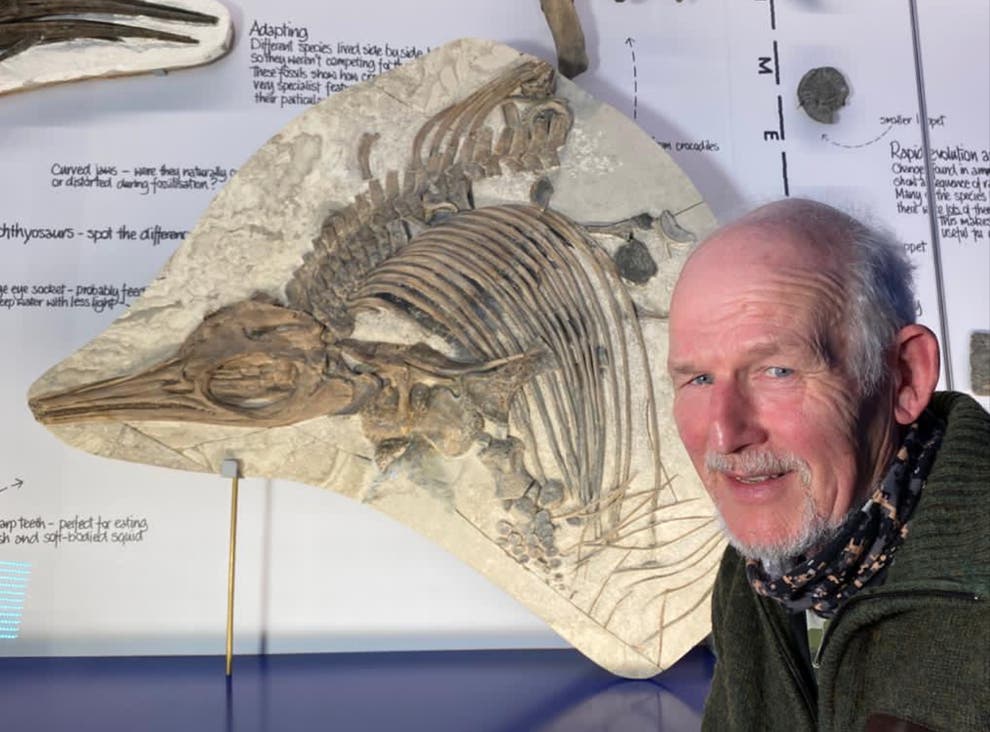When astronomers first detected Threeey Atlas using the Hubble Space Telescope, it appeared to be a harmless interstellar rock, a few hundred meters wide, drifting toward the Sun. NASA logged it as another minor deep-space visitor and moved on. Days later, however, new images revealed a startling shift that changed the narrative entirely. Hubble’s next image no longer showed a rock but a metallic body with a glowing red and yellow tail, resembling molten steel pouring into the void. Even more bizarre, unlike every known comet whose tail streams away from the Sun, this tail pointed inward, directly toward the Sun—like the exhaust of a rocket firing its engines. Harvard astrophysicist Avi Loeb voiced what others hesitated to say: this could indicate advanced propulsion. Without concrete data, however, the idea remained speculative.
Then, on September 7, the James Webb Space Telescope captured a sharper image that stunned the world. Overnight, the red and yellow tail had transformed into a deep, neon-green beam pulsing like a heartbeat. Each pulse corresponded with precise shifts in the object’s trajectory, as if guided by invisible hands. For NASA scientists accustomed to predictable comets, this was shocking. Avi Loeb, unwavering, declared the data undeniable: “Threeey Atlas is no longer a comet but an interstellar craft, a machine powered by physics and chemistry far beyond human capabilities.” He presented hard numbers and observations to support his claim, raising a chilling question: why did the tail suddenly turn green?
Kapatal, a senior aerospace propulsion specialist at NASA’s Advanced Propulsion Lab, explained, “That strange glow isn’t just a color—it’s a clue to what’s happening inside the object.” When the James Webb Space Telescope analyzed the light from Threeey Atlas, splitting it into a spectrum, it detected almost no water vapor. Instead, it found carbon dioxide, cyanide, traces of carbon monoxide, and clouds of nickel dust—gases not typical of comets but ideal for a high-efficiency plasma engine. Such an engine works by stripping electrons from gas to create plasma, then using electric or magnetic fields to propel it out the back, generating thrust far more efficient than traditional rockets. Carbon dioxide provides heavy propellant, cyanide conducts electric charge for magnetic manipulation, and nickel dust adds mass while shielding the core. The eerie green glow, far from being sunlight or paint, is the signature of ionized carbon and cyanide under a powerful electric field. On Earth, similar green hues appear in labs when these gases pass through high-voltage arcs, as electrons leap between energy states. In space, at this scale, it signals one thing: someone is operating a plasma drive.
From an engineering perspective, the system is almost too elegant to be real. According to Loeb, at its core is a compact nuclear reactor producing an estimated 10 gigawatts—enough to power an entire nation—compressed into a chamber the size of a city block. The nickel core serves as both an engine block and a radiation shield, containing temperatures hotter than a star’s surface while protecting the advanced systems within. The pulses, occurring every 232 seconds, align with subtle changes in speed and direction, impossible for sunlight-driven comet activity. This is deliberate propulsion. The green jet acts as both thrust and camouflage, a rippling curtain of ionized gas that moves the craft while concealing its true shape. Each pulse is a timed discharge from the 10-gigawatt core, a precise push as controlled as an engine firing.
As Threeey Atlas neared the Sun, its color shift signaled a change in engine mode. The initial red-yellow phase was a low-energy discharge, like a jet engine warming up. Closer to the Sun, it began tapping the Sun’s magnetic field, charging the plasma to higher energy and producing the green glow. Scientists anticipate a blue-white phase soon, indicating ultra-hot plasma at maximum thrust. Each pulse adjusts the craft’s speed and direction with engineering precision, mimicking how spacecraft throttle between power modes. This behavior defies conventional comet physics: tails shouldn’t point inward, pulse rhythmically, or decelerate independently, yet Threeey Atlas does all this, aligning perfectly with Earth’s orbital plane. NASA’s orbital data show it slowing from 88,000 km/h to 87,000 km/h in just two weeks—an impossibility without active propulsion.
Even stranger, as the object approaches the Sun, radio telescopes on Earth detected a signal at 1,420 MHz—the hydrogen line, a frequency used to search for interstellar communication. The signal spikes with each brightening of the green plume, matching the rhythm of the engine pulses like a second heartbeat. To radio engineers, this suggests a transmitter or an energy system leaking a carrier wave. The signal, weak but structured, resembles an encrypted message or the byproduct of a city-sized power grid. No natural comet emits at this frequency, making it a cosmic anomaly. Threeey Atlas isn’t just glowing—it’s humming at us.
NASA has issued a warning: the green plasma exhaust could sweep through orbital space, with cyanide gas and nickel dust acting like a charged sandstorm, capable of frying solar panels, disabling antennas, and short-circuiting electronics. Satellites, designed for the vacuum of space, are unprepared for an alien exhaust cloud. For the first time, space agencies are drafting emergency protocols for an interstellar craft crossing Earth’s orbital path. To confront this, NASA announced Juno 1, a rapid-response probe built on an accelerated schedule. Equipped with a ceramic-nickel shield to withstand cyanide ions and nickel dust, Juno 1 will dive through the plasma tail, tracking the radio signal and filming the engine up close. If launched on time, it will be the first spacecraft to approach an alien drive system in action, glowing green across the sky. Engineers warn that even getting close is risky—the tail behaves like a living current of charged particles, pulsing with 10 gigawatts of power. A miscalculation could vaporize Juno 1, but success could reveal the nickel lattice, plasma nozzles, and the green heart of the engine itself.
Amateur astronomers are also observing effects. With modest telescopes, they report faint flashes along the tail, resembling Morse code, which NASA has confirmed as real. Some see braided strands in the plume, and the bright central point remains sharp regardless of camera exposure, possibly the magnetic nozzle of the alien engine visible through thinning camouflage. NASA predicts the craft will soon shift to a blue-white plasma phase, potentially decelerating to exit the solar system or slowing to enter an orbit between Earth and Mars. If it matches our orbit, humanity will face the first visiting machine from another star—one that may be watching us as it approaches the Sun, changing color and chemistry daily.
Somewhere out there, a machine older and more advanced than anything on Earth is entering our solar system. We are witnessing the first chapter of contact. The only question is: what will it do next? Share your thoughts in the comments below, and to stay updated on this unfolding story, like and subscribe for the latest developments. You won’t want to miss what happens next.























